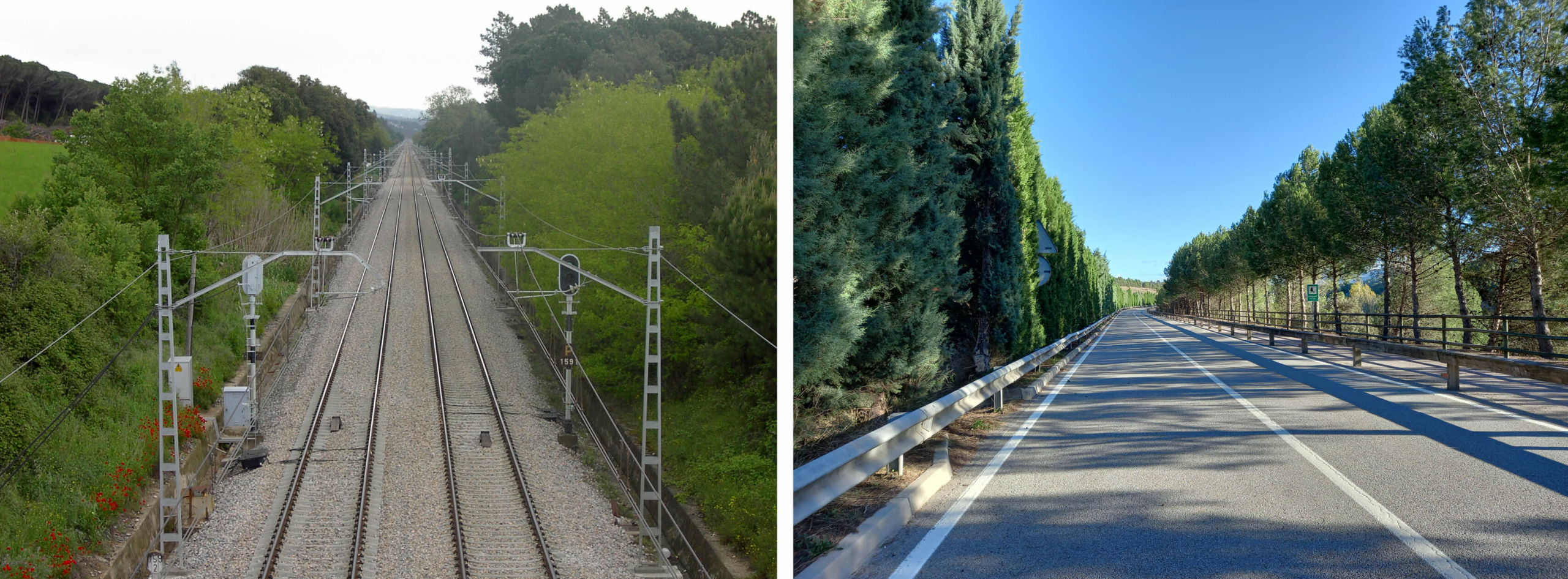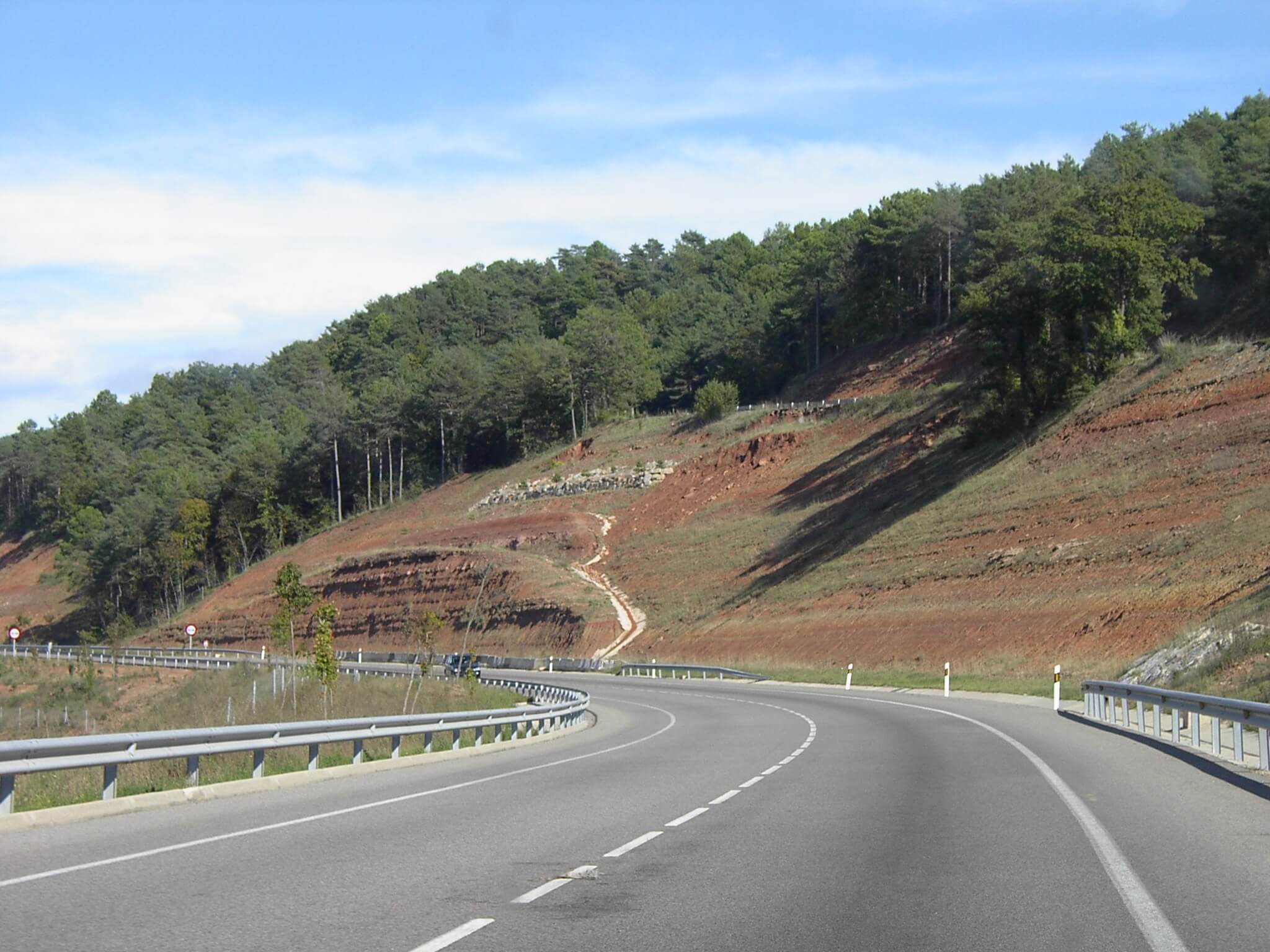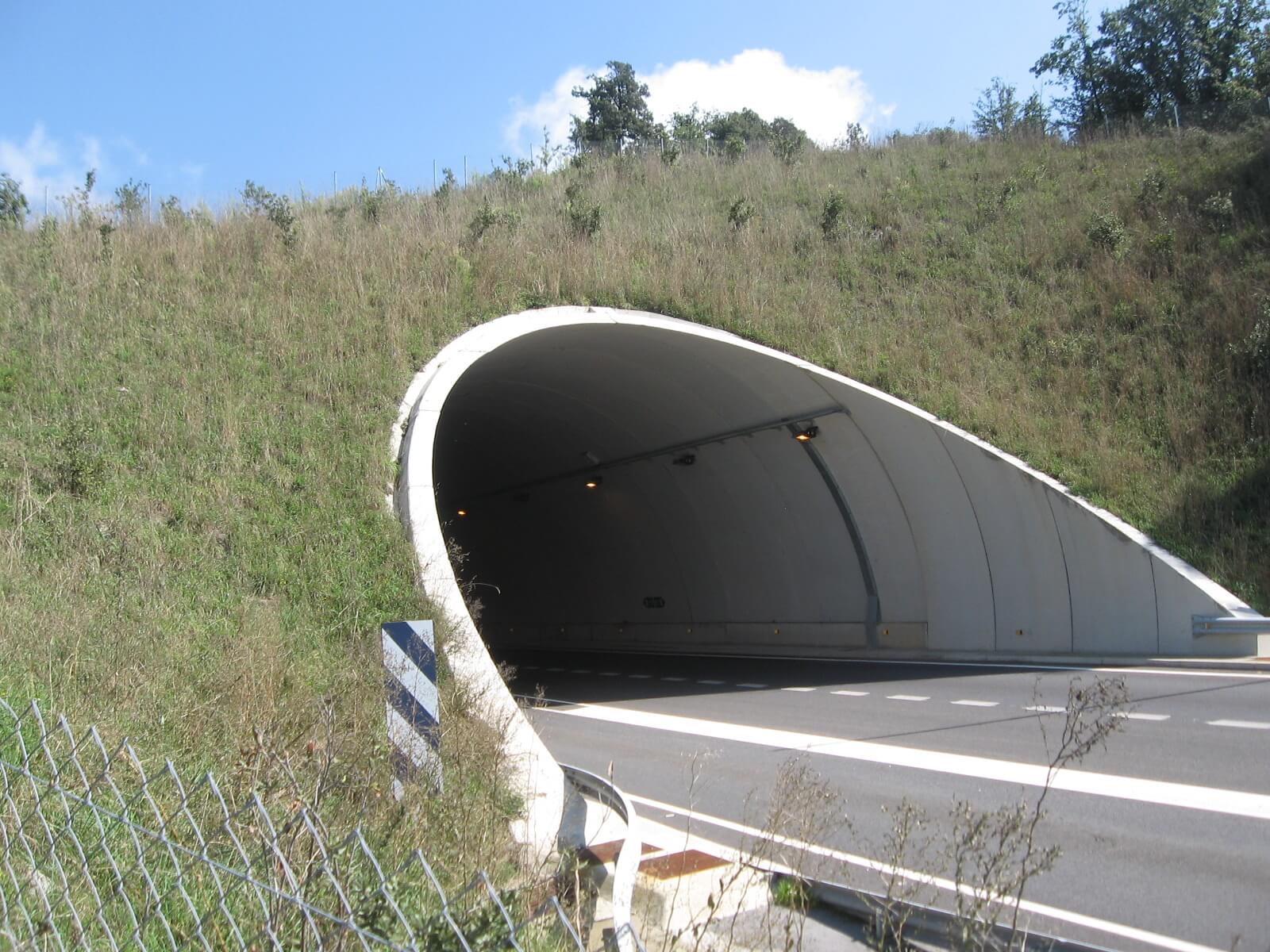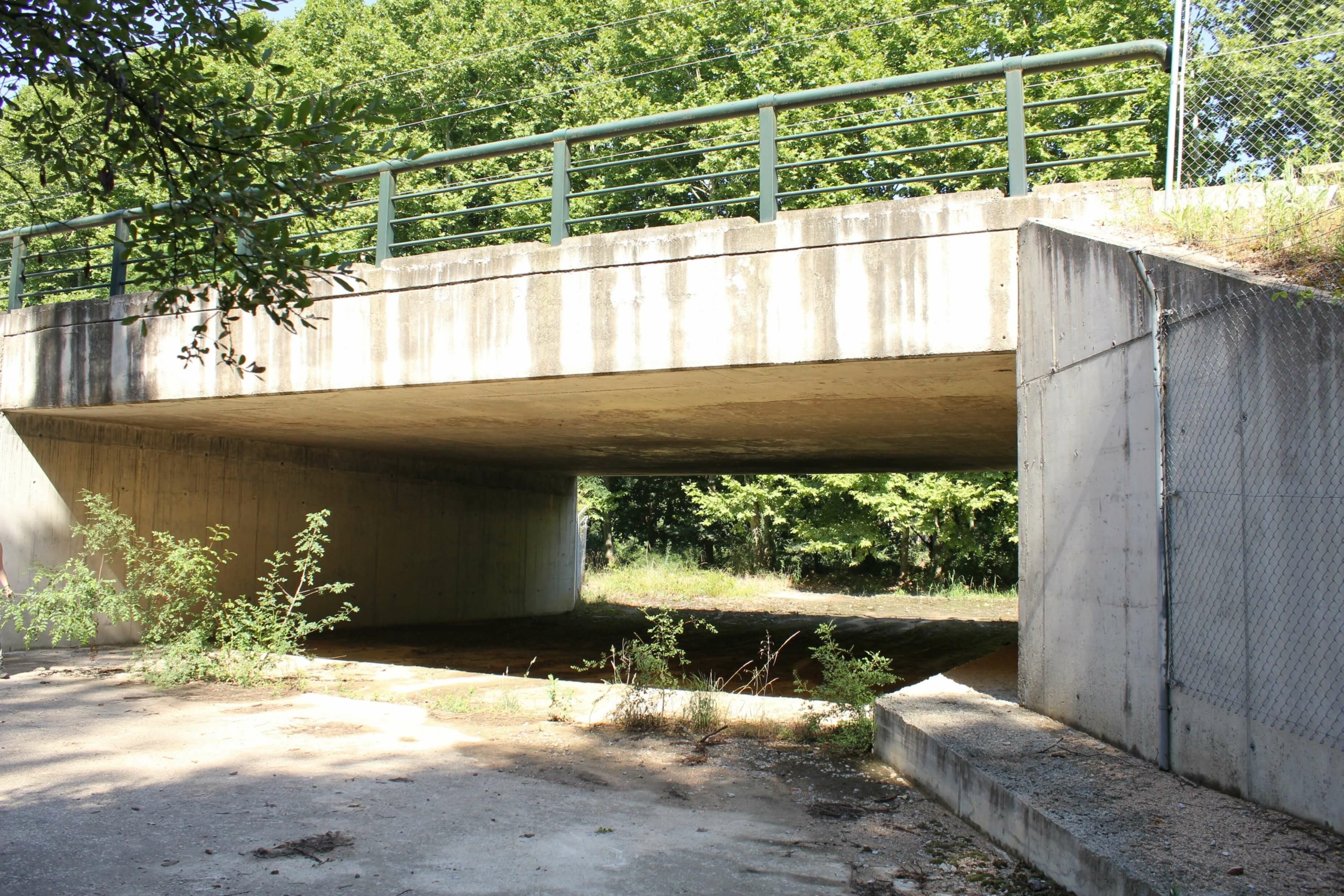The following sections focus on features frequently integrated in transport infrastructure and provide recommendations on how best to design them in order to minimise negative impacts on biodiversity.
Earthworks: cutting and embankments
Cuttings and embankments are components that, in general, help with route alignment (Figure 4.3.7). Well-designed examples can also better integrate the infrastructure with natural landforms or even provide opportunities for various habitats to be created. The following aspects should be considered:
- Traffic safety: appropriate design of cuttings and embankments always must contain escape routes for people in case of emergency. They also should effectively prevent wildlife from crossing the infrastructure, especially larger animals, and secure potential falling stones or other material on steeper cuttings.
- Perceptual integration into the landscape: usually by grading out of earthworks to suitable slopes, which also ensures efficient use of materials. In certain areas, irregular cuttings (e.g., in woodland changing with rough pasture) or false cuttings (especially in gently undulating ground) are effective solutions. Rock outcrops can be created as most appropriate in other locations. It is also beneficial to round off the tops of cuttings to a gentle profile or to use terracing to break up the sides of deep cuttings to overcome their visual dominance, with the added benefits of better structural stability and the establishment of vegetation.
- Mitigation of the effects of disturbance: usually with good perceptual integration into the landscape, which often brings reductions in noise, light, pollution, and other negative effects of transport infrastructure on fauna.
- Biodiversity benefits: earthworks and other infrastructure edges can become interesting habitats and host various plant and animal species (see Chapter 5 – Solutions to mitigate impacts and benefit nature). Examples include rock exposures in upland areas, rich xerothermic communities or habitats with native grasses or bushes. Respecting the local natural character and ensuring appropriate management and maintenance are key (see Chapter 7 – Maintenance).
- Maintenance: keeping all infrastructure elements functional and in good condition is essential. For this reason, regular maintenance must be accurately planned (see Chapter 7 – Maintenance).
Junctions and roundabouts
Highway junctions and roundabouts can be wildlife traps or create habitat islands and are very intrusive unless well located and designed with earthworks at a scale appropriate to minimise the impact of any signs, gantries, lighting and overhead crossings. They should be designed to avoid fragmentation with good connections above or below the carriageways as is appropriate for the wildlife species living in the area. Connectivity between the segments of a major interchange may be important for the movement of fauna and can be achieved by including appropriate wildlife passages. These structures must be combined with fencing (see Chapter 5 – Solutions to mitigate impacts and benefit nature. Wildlife passages).
Tunnels
Tunnels may be the best design solution to protect high-value landscapes and are also a desirable solution from engineering point of view compared to extensive excavations and high embankments. There are two basic methods of tunnel construction: bored tunnels and cut-and cover tunnels. Bored tunnels allow sites of high nature conservation value to remain intact causing minor damage to environment.
Cut-and-cover tunnels may be appropriate to provide landscape overpasses where bored tunnels are not feasible, restoring habitats and ecological connectivity (Figure 4.3.8; see Chapter 5 – Solutions to mitigate impacts and benefit nature. Landscape overpasses).
- Reuse of the original soil extracted should be considered if it can be excavated and stored in a way that minimises compaction and loss of structure. The soil profile should be constructed to match the adjoining profile in order to reproduce the hydrological characteristics as well as the physical structure and chemical properties of the original substrates.
- Restore the surface of the structure appropriately to provide mosaics of natural vegetation types and a variety of refuges and habitats suitable for a wide range of species including vertebrates and other small fauna.
- Provide appropriate connections to surrounding habitats, together with fencing that guides medium and large mammals to the structure, both of which are essential elements.
Drainage
The main goals of water run-off management are:
- To safely drain water from precipitation of transport infrastructure.
- To control integration of this water into the surrounding environment, so that no damage to property, nature or water resources is caused.
- To create the ability to capture any polluted water in case of accidents.
Associated water management features such as drainage, ditches and retention ponds, need to be built in a way that ensures their integration into the landscape, without the creation of barriers or traps for animals and, if possible, improved conditions for fauna in the surroundings (Figure 4.3.9). Comprehensive recommendations for adapted drainage to provide wildlife passages are provided in Chapter 5 – Solutions to mitigate impacts and benefit nature. Adapted culverts and in Chapter 5 – Solutions to mitigate impacts and benefit nature. Multiuse underpasses.
Fencing and screens
Fences and walls, including noise and screen barriers, may create serious barrier effects as well as a significant impact on the appearance of the transport infrastructure in the landscape. Their use should be restricted only to locations where it is judged absolutely necessary, such as where effective reduction of fauna mortality and improvement of traffic safety is required. Technical prescriptions for these components are provided in Chapter 5 – Solutions to mitigate impacts and benefit nature. Fencing.
Restored vegetation
Planting vegetation is a common part of transport infrastructure projects. How this is done is based on the natural conditions in a given area, mainly related to climate and the characteristics of natural vegetation in the area. For this reason, the choice of species and other parameters of planting will vary widely in each region. Restored vegetation constitutes a new ecological element in the landscape and how it relates with surrounding habitats is complex. The functionality and value of such vegetation and habitats may vary depending on the different target species concerned or traffic safety goals in the area. Because vegetation restoration can have both positive and negative effects, the best design which optimises function must be chosen based on local conditions. Restoring vegetation must fulfil some basic general functions:
- Stabilization of slopes to prevent landslides and protection of this soil from water erosion. Technical solutions are particularly important where there are longer slopes on embankments and cuttings immediately adjacent to the infrastructure, as soon as construction is completed. This includes technical grassing of slopes, as it can take some time for vegetation to become established.
- Intended effects of vegetation on the operation of the infrastructure, including microclimate effects such as increasing humidity or limiting gusting wind; health effects such as the reduction of dust or noise; and traffic safety effects such as providing optical cues to infrastructure users, reducing the glare of oncoming traffic and creating physical safety barriers.
- Landscaping into the area, improving the appearance of the infrastructure and enhancing its perception from adjacent areas, with a positive effect on the landscape´s character and perception (Figure 4.3.10).
- Biological and ecological function: increasing the stability of the landscape, creating the maximum potential for biodiversity and reinforcing the ecological network of the landscape to compensate for the negative effects of transport infrastructure.

The biological and ecological function is crucial from the viewpoint of biodiversity conservation. Several key considerations in this context are:
- The suitability of certain types of vegetation adjustments depends mostly on surrounding habitats. Cuttings and embankments are always more sun-exposed and drier than surrounding habitats and often host high ecological value vegetation adapted to dry and hot conditions. For this reason, it is generally advisable to allow natural colonisation by local plants rather than artificial planting, where possible.
- Due to their steppe character, embankments and cuttings represent migration routes for thermophilic species along the road or railway, which is also supported by regular management of verges, such as mowing. Verges sometimes constitute suitable habitats for many invertebrate species and reptiles.
- Road and railway verges can also pose environmental threats. They can create corridors for the spread of Invasive Alien Species. If vegetation along the infrastructure is attractive for such species, higher concentrations of such species can cause increased mortality of local species. When setting up or maintaining verges, these risks need to be considered and minimised as much as possible.
- Keeping a nude verge, which has no or very minimal planting near the carriageway is also advisable in specific locations to reduce the risk of vehicle collisions with large animals (Figure 4.3.11). It increases visibility and makes it easier for both drivers and animals to react correctly. This solution also avoids attracting vulnerable species to areas where a high risk of collision with cars has been observed and reduces the risk of forest fire spread.
- Fruiting trees growing near the infrastructure create important habitats for many species and improve the aesthetic value of the landscape. However, these trees can also create attractive feeding spots for some animals, which can influence how frequently animals cross the road or railway. Therefore, planting fruiting trees near the carriageway on infrastructure with higher traffic intensity should be carefully considered, as it may cause a higher mortality of animals and increase the risk of accidents involving wildlife.
- The slopes of embankments and cuttings often include also rocks or stony rubble that can be suitable habitats for reptiles and invertebrates. Such features providing refuges to small animals should remain untouched as much as possible.
- For traffic safety reasons it is not recommended that trees which could be vulnerable to falling by storms or gusting wind be planted close to infrastructure.
- When leaving space for natural colonisation of vegetation adapted to dry habitats, suitable maintenance will be necessary, such as the periodic pruning of shrubs and trees (see Chapter 7 – Maintenance).
- Proposals to adjust vegetation must also take into account this issue of perimeter fencing. If planted close to a fence, woody vegetation may damage it and create an opening that allows animals access to the carriageway (see Chapter 5. Fencing. Other points of attention). In the same way, planting around the infrastructure may permit animals to climb over boundary fencing and access the infrastructure. Restoration of vegetation should be based on the usage of local plant species, corresponding to given soil and climatic conditions, especially in rural areas. Where possible, natural regeneration is the best way to achieve the ecological functions of verges. Planting of invasive alien species must be avoided.
Lighting and noise
Lighting and noise management are part of an appropriate integration of transport infrastructure into the landscape, as they influence how local residents and users perceive the infrastructure and can have a major effect on local biodiversity. Management of these factors is further developed in Chapter 5 – Solutions to mitigate impacts and benefit nature. Measures to reduce disturbances.



